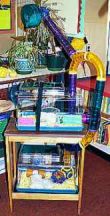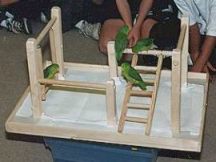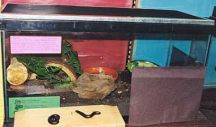Cover Story...
Guidelines for Classroom Pets
by Nora Boekhout
Continued from Classroom Pets
A pet in the classroom - what a joy and delight it can be, not to mention the opportunity to learn first-hand about responsibility, caring, and gentleness! Children regularly come knocking on your door after school to ask, "Can I show my friend the new fish?" or early in the morning with "Do you need any help with your hamster?" On the other hand, many teachers find pet keeping to be a burden. The sad story of neglected animals at the back of the room continues to repeat itself. This article is written in the hope of making your pet-keeping experience a positive one - for you, for your students, and certainly for your class pet!
Why get a class pet?
If you are reading this article,
 then most likely you already know the best reason... YOU like animals! Nonetheless, you don't have to be a huge enthusiast to be successful, you just need to be a responsible member of "Planet Earth". A foremost reason for animals in the classroom is to give students first-hand experience with some of Mother Nature's other lifeforms. By taking on a role of guardianship in the classroom, we hope to instill a respect for life outside the school walls. A sense of responsibility is built up as the children realize just how important their care-taking duties are. This also can reinforce their self-esteem - they do make a difference, and they have a significant role. Teachers note that these benefits can be especially important to troubled, shy, or disabled children. A child from another country, struggling to learn the new language, has no trouble talking to the class guinea pig or feeding him carrots. A child who "can't seem to get it right" in other areas, can often explain to visiting parents about how the tadpoles turned into frogs. With some animals, such as reptiles, you may also be helping children deal with their fears and misconceptions. With others, such as insects, you may be able to give some instruction on how many of these creatures, so often squashed without a thought, may have an important role in nature. An excellent perspective on the joys of pet-keeping is available at the Classroom Animals and Pets website ... "The Benefits of Pets in the Classroom" by teacher J. Goodwin.
then most likely you already know the best reason... YOU like animals! Nonetheless, you don't have to be a huge enthusiast to be successful, you just need to be a responsible member of "Planet Earth". A foremost reason for animals in the classroom is to give students first-hand experience with some of Mother Nature's other lifeforms. By taking on a role of guardianship in the classroom, we hope to instill a respect for life outside the school walls. A sense of responsibility is built up as the children realize just how important their care-taking duties are. This also can reinforce their self-esteem - they do make a difference, and they have a significant role. Teachers note that these benefits can be especially important to troubled, shy, or disabled children. A child from another country, struggling to learn the new language, has no trouble talking to the class guinea pig or feeding him carrots. A child who "can't seem to get it right" in other areas, can often explain to visiting parents about how the tadpoles turned into frogs. With some animals, such as reptiles, you may also be helping children deal with their fears and misconceptions. With others, such as insects, you may be able to give some instruction on how many of these creatures, so often squashed without a thought, may have an important role in nature. An excellent perspective on the joys of pet-keeping is available at the Classroom Animals and Pets website ... "The Benefits of Pets in the Classroom" by teacher J. Goodwin.
http://www.teacherwebshelf.com/classroompets/whatsnew-TOC.htm
Getting started
It is important to take some time deciding what kind of pet you are suited to. This is every bit as important as choosing a pet for your home, maybe even more so! As a general rule I would not recommend taking over "someone else's change of heart". If you aren't enthusiastic about learning how to care for an unexpected animal, the result will be disappointing for both you and the pet. The bottom line is...
 these are living creatures and if they are to be kept captive, they deserve the best we can provide. If you are letting your class decide on the type of pet, be firm in what you "won't" accept. An excellent article on "Choosing A Classroom Pet - A Problem-Solving Experience" by teacher S. Zuckerman is available at the Classroom Animals and Pets website.
http://www.teacherwebshelf.com/classroompets/whatsnew-TOC.htm
these are living creatures and if they are to be kept captive, they deserve the best we can provide. If you are letting your class decide on the type of pet, be firm in what you "won't" accept. An excellent article on "Choosing A Classroom Pet - A Problem-Solving Experience" by teacher S. Zuckerman is available at the Classroom Animals and Pets website.
http://www.teacherwebshelf.com/classroompets/whatsnew-TOC.htm
Some general points to consider are:
- What general type of animal are you interested in? (mammal, reptile, insect, fish, bird etc.)
- Are you looking for a social pet or do you enjoy creating a realistic habitat?
- Are you looking for a "typical pet" or something unusual?
- Is the pet itself the focus or is the habitat the focus?
- Is the choice of pet related to your curriculum planning?
- What grade level are you teaching? For example, younger children need more docile pets.
- How much noise or distractions can your teaching style handle?
- How much mess or animal odour is comfortable for you?
- Are you prepared to take the animal home on weekends or does it need to be one that can be alone for a few days? What about longer holidays?
- Are you looking for a short-term project or a pet to keep for several years?
- How much time are you willing to commit to upkeep?
- How much money are you willing to spend on set-up?
- How much space do you have available in your classroom?
- What facilities do you have in your classroom for washing up and disinfecting cages etc?
- What are the regulations for pets in your school district?
- Are there special considerations regarding pets in your own school?
- What are the tolerance levels of the teachers in the classrooms beside you?
General Set-up Considerations
- Always try to obtain the tank, cage, or container well in advance.

- In purchasing new equipment, check more than one local pet store. There are big differences in price and you can often obtain an educator's discount. It is worthwhile, however, to have one "favourite store" as it can be helpful if they get to know you.
- Always obtain several books or Internet fact sheets on your animal, well in advance, and read them several times! If possible, get in contact with a knowledgeable teacher too.
- In the case of purchasing new equipment, don't skimp on size of cage... that's your animal's main place of existence!
- In the case of used equipment, check very carefully for sharp edges, broken pieces, faulty lids, possible escape routes!
- When choosing a location for the tank, most animals should not be under a window or in a draft.
- Some animals require electrical outlets nearby for heaters, lights etc.
- Earthquake regulations suggest that any glass tanks be well away from emergency exits.
- Make sure that you know what kind of substrate is appropriate for your animal (soil, sand, wood chips etc.) Read up on this carefully. For example, cedar chips are not healthy for hamsters and guinea pigs, large grain sand can cause stomach problems in small lizards, aquarium water needs to be aged and tested for chemical imbalances long before you purchase the fish.
- Make sure you know what other "paraphernalia" besides food is needed (i.e. hiding places, chew sticks, mineral blocks, heaters etc.)
The Big Day!
When that exciting day
 of obtaining your new pet arrives, don't forget that it will need some time to get accustomed to its new surroundings. If school is already in session, let your class know that "the first day of school" can be a bit intimidating to a pet as well as a student! A little consideration with respect to noise and peering faces would be appreciated. Once your pet seems accustomed to its surroundings, the students can then begin to interact (depending on the type of pet, of course!)
of obtaining your new pet arrives, don't forget that it will need some time to get accustomed to its new surroundings. If school is already in session, let your class know that "the first day of school" can be a bit intimidating to a pet as well as a student! A little consideration with respect to noise and peering faces would be appreciated. Once your pet seems accustomed to its surroundings, the students can then begin to interact (depending on the type of pet, of course!)
This settling-in period is a good time to do extra reading with the class on care and maintenance... even if they think they already "know what to do". Children with pets at home can offer their "expert advice" on routines. Investigation into the "real life" habitat of your chosen animal is also important.
Questions?
While there are many books on the market for handling pets, keep in mind that a fellow teacher is often the best resource for finding out how an animal may or may not suit a classroom setting. That statement is, in fact, the reason I began my own website! If you have questions, please take advantage of the opportunities via the Internet! Here's hoping your experience with pet-keeping turns out to be a mutually satisfactory one!
|

